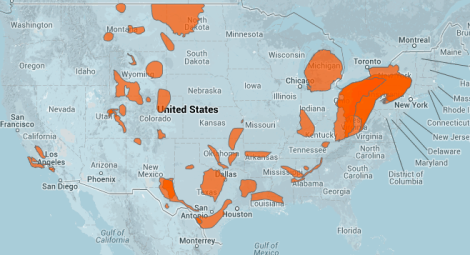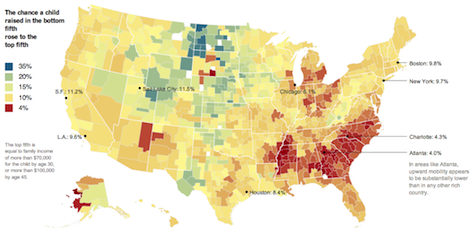Want to give your kids a chance at a better life in this flagging economy? Well then get thee to the oil and gas fields, America.
That’s certainly how I read this piece in The New York Times this week, “In Climbing Income Ladder, Location Matters,” based on new research [PDF] from Harvard and the University of California Berkeley — the best income mobility study in the U.S., they say.
The Times created an interactive map that breaks down a child’s chance at rising out of poverty by region, revealing massive geographic disparities between the intergenerational winners and losers. Most-mobile areas are in blue; least-mobile are in red.
But as to why this is happening? The researchers point to correlations between intergenerational mobility and income inequality, segregation, school quality, family structure, and local taxes — basically, the usual social civic infrastructure stuff. Noted urbanist Richard Florida had his own theories on the pattern.
My takeaway from new mobility study: Mobility more likely in big cities & knowledge centers, much less likely in Deep South and Rustbelt.
— Richard Florida (@Richard_Florida) July 22, 2013
That urbanist argument isn’t totally without merit: The Deep South and post-industrial Rustbelt have hit the economic skids in recent decades, and this research shows that those residents are at a serious disadvantage compared to other regions, city or no city.
But some of the most intensely mobile places in America — North Dakota, Northeast Utah, West Texas — are not full of large cities and tech startups. They’re full of natural resources that are being extracted as fast as these places can import the young (mostly) men to do that job. San Francisco and Seattle may have tech, but Utah, Colorado, and Wyoming have the Uintah Basin; New York may have finance, but North Dakota has the Bakken shale.
Comparing the Times’ map to this one from Earthjustice makes the correlation even more clear. The orange areas are all active fracking operations (updated as of 2011).

Earth JusticeClick through for the fully interactive version.
North Dakota in particular has a record surplus and a minuscule unemployment rate. Interestingly, the Times doesn’t include any stories from drill-happy regions in the article.
All that new wealth comes at a cost — and not just to the planet. Those high-paying fracking jobs are dangerous, the workers expendable, and the work itself tenuous. Oh yeah, and some experts even think the whole booming industry might be an economic bubble.
Fracking has certainly offered one route out of poverty for a small subset of Americans — at least for as long as those well-paying jobs last. But if we’re serious about creating better social mobility stateside, we need to think about more than just drilling. Real solutions will require deep socioeconomic changes, from renewable energy to better public transit to public investment in improving infrastructure. Maybe then the cities will outshine the oil fields when it comes to real, lasting opportunities.




